FOR IMMEDIATE USE
1 in 10 West Australians with epilepsy sustaining serious physical injuries
Call to improve community awareness, support & response to seizures this Purple Day®
One in 10 West Australians living with epilepsy experience a seizure-related injury each year, many of which are potentially life-threatening, according to an article just published in MJA InSight to mark Purple Day® (an international epilepsy awareness day).1
The most commonly reported seizure-related injuries sustained by those living with the neurological (brain) disease include head (one-in-four of which require stitches), water immersion (almost 26 per cent), driving(14 per cent), burns (14 per cent), fractures (10 per cent) and dental-related injuries (10 per cent).1,2
Doctors, advocacy groups, patients and their families are joining forces Australia-wide today to highlight the serious injuries caused by epileptic seizures, and call for heightened awareness, understanding and support for the 14,727 West Australians living with active epilepsy,3 to create calmer waters through which they can safely navigate their physical journey with the disease.
According to MJA InSight article co-author and Consultant Neurologist and Epileptologist, Royal Prince Alfred Hospital and Sharp Neurology, Dr Kaitlyn Parratt, Sydney, experiencing even one seizure a year can pose risk of serious injury.1
“A seizure is the result of abnormal, excessive or recurring electrical activity in the brain,4 noting there is tremendous physical risk associated with experiencing seizures.
“One in three Australians living with epilepsy will sustain a seizure-related injury in their lifetime, more than 50 per cent of which will prove particularly dangerous to the head, or will occur at home in the bath or swimming pool,” 2 said Dr Parratt.
“Australians living with epilepsy are at 15-to-19 times greater risk of drowning than the general population,1,5 and are also at risk of sustaining a range of other injuries, including burns, serious fractures, dislocations and car accidents.1,6
“It is therefore vital we improve community understanding of the physical dangers faced by those experiencing epileptic seizures, and educate people on how to react in the event of a seizure, to help maximise patient safety,” Dr Parratt said.
The epilepsy community’s call today coincides with the launch of ‘Look for epilepsy’ – a UCB-led community engagement initiative designed to highlight the much-needed support available to those living with epilepsy, and their carers, while raising awareness of the brain disease. The initiative urges Australians to lend their support to members of the epilepsy community by visiting , taking a selfie with a purple glasses filter on the site, and sharing the selfie on their social media channels to support epilepsy awareness, using the hashtag #lookforepilepsy.
MJA Insight article co-author and neurologist, epileptologist and epidemiologist, A/Prof Wendyl D’Souza, St Vincent’s Hospital, Melbourne, who is supporting the Look for epilepsy initiative, hopes new and improved ways of predicting seizures will reduce risk factors for Australians living with epilepsy.
“Concerningly, people living with epilepsy have a mortality rate of up to three times higher than the general population.7 A frequent cause of epilepsy-related death is Sudden Unexpected Death in Epilepsy (SUDEP), where sudden death occurs in a person with the disease for no apparent reason.8
“However, according to emerging Australian research into seizure patterns, while long-considered to be unpredictable, there is, in fact, a person-specific long-term pattern to seizures in most (80 per cent) cases,”1 said A/Prof D’Souza.
“The ability to forecast when someone may be at high risk of seizures through wearable devices, for instance, may help to reduce uncertainty, and allow for the implementation of preventative strategies to minimise the risk of physical injury, and SUDEP.”1
Epilepsy support counsellor, Hayley, 49, Perth, experienced her first convulsive seizure without any forewarning at the age of 35.
She experienced her second seizure six months later, which left her bruised, with a head injury and a severely bitten tongue. She was readmitted to hospital, where a neurologist and additional tests confirmed her diagnosis of epilepsy.
“Epilepsy was affecting both my family and I. It was scary for them to watch me having a seizure. They were concerned about me, so I couldn’t put them in danger as well,” Hayley said.
Hayley’s diagnosis led to a host of necessary lifestyle changes. She was unable to drive and was required to rigorously adhere to making healthy lifestyle choices to avoid triggering any further seizures. Her diagnosis was also the catalyst for a career change, from a medical scientist, to a counsellor, enabling Hayley to help others in their journey with epilepsy.
“I find the adjustments to my lifestyle particularly challenging, given I’m not the personality type to restrict myself of life’s pleasures.
“Epilepsy doesn’t dictate my life. But the uncertainty of having yet another seizure is always at the back of my mind,” said Hayley.
“This Purple Day®, I’m calling for people to recognise the seriousness of epilepsy, the dangers of seizures, and the daily physical and mental challenges faced by people like me.”
Epilepsy WA CEO, Emma Buitendag, hopes improving awareness of epilepsy will serve to address the abundant myths and misconceptions surrounding the disease.
“There are many common myths and misconceptions involving epilepsy. Epilepsy is something everyone has heard of, but that’s usually the extent of their knowledge. Some people think it’s psychiatric in nature, but it’s certainly not. It’s very physical.
“That’s why the Look for epilepsy initiative is so important, because it allows our community to raise awareness of epilepsy, and reinforce the much needed support available to those in need,” Ms Buitendag said.
Today (March 26) is Purple Day®, a global initiative that aims to heighten community awareness of epilepsy. Through the joint efforts of Epilepsy Action Australia, Epilepsy Australia, Epilepsy Queensland, Epilepsy ACT, the Epilepsy Foundation, Epilepsy Tasmania, The Epilepsy Centre (SA and NT) and Epilepsy WA, more than 100 landmarks Australia-wide will turn purple this evening, to honour this important occasion, and applaud those living with epilepsy locally, and around the world. Some of the Australian illuminations will include the Story Bridge in Brisbane, The Royal Mint in Canberra, The Melbourne Star Observation Wheel, Government House in Hobart, Adelaide Oval and the Optus Stadium in Perth.
· To join the Look for epilepsy initiative, head to .
· Epilepsy WA provides a state-wide network of support groups, a telephone information line, innovative Epilepsy Smart Schools program, epilepsy training and a free seizure monitor alert program for West Australians living with an epilepsy diagnosis and their families.
· To access support, information and innovative services for those living with, and affected by epilepsy, head to or call 1300 852 853.
About epilepsy
Epilepsy is a common brain disease involving recurrent seizures9 caused by a temporary disruption of electrical activity in the brain.9 Epilepsy is not just one condition,10 there are many different types, characterised by recurrent seizures,11 noting not all seizures are epileptic.12
Epilepsy can develop at any age, regardless of gender or ethnicity.10,12 However, epilepsy is more likely to be diagnosed in childhood or senior years, noting children represent approximately 40 per cent of the epilepsy population.9Epilepsy affects an estimated 50 million people world-wide,7 with an estimated three-to-four per cent of Australians will develop epilepsy in their lifetime.10 The total annual cost of epilepsy in WA is approximately $1.2 billion.3 This includes substantial health system costs, costs associated with loss of productivity, the cost of informal care and equipment and transport costs.3
Purple Day is a Registered Trademark of The Anita Kaufmann Foundation.
ends#








